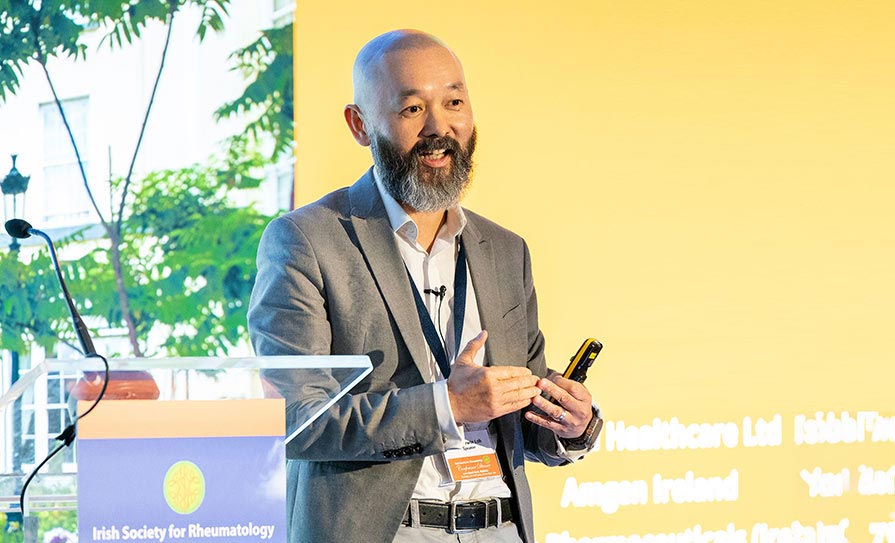Prof McDonnell receives Award for outstanding contribution to respiratory medicine
The Irish Thoracic Society (ITS) Annual Scientific Meeting 2023 featured a distinguished line-up of national and international speakers, researchers, and experts that examined clinical excellence across the vast spectrum of respiratory medicine, as well as the rapidly changing landscape of care delivery in Ireland. The four pillars of the ITS – communication and advocacy; education and training; research; and membership services – all featured heavily throughout the event, which began with specialist registrar training, a case study review forum, and poster discussions.
The highlight of the meeting was the presentation of the Award for Outstanding Contribution to Respiratory Medicine to Prof Tim McDonnell, retired Consultant Respiratory Physician at St Vincent’s University Hospital, Dublin, and current Chair of the Board of COPD [chronic obstructive pulmonary disease] Support Ireland. The award was presented on behalf of the ITS by Prof McDonnell’s friend and colleague Prof Charlie Gallagher. Prof McDonnell expressed both delight and gratitude at the honour.
Mucus plugging and adverse outcomes in asthma and COPD
The first guest speaker at the Irish Thoracic Society Annual Scientific Meeting 2023 was Dr Eleanor Dunican, Consultant in Respiratory Medicine at St Vincent’s University Hospital, Dublin, and Associate Professor in University College Dublin. Dr Dunican has a special interest in asthma, and delivered an engaging overview of the role of mucus plugging in the pathophysiology of the disease, and explored the potential CT imaging has to identify a novel mucus phenotype. Her presentation was entitled ‘Seeing is believing: Imaging of mucus plugs in asthma and COPD’.
Referencing her own notable body of work and other relevant studies throughout, Dr Dunican began with a general overview of segmental ventilation defects on MRI imaging, and their direct associations with airflow limitation in asthma patients. “These ventilation defects are far more pronounced in asthma patients who are eosinophilic, and tend to persist after bronchodilation,” she said. Dr Dunican then presented a wealth of evidence verifying correlations between mucus plugging on CT imaging and these ventilation defects on MRI.
Dr Dunican said she and her team “were surprised by how common mucus plugging was in asthma”, and that “the amount of segmental defects were significantly higher” if a mucus plug was also present. “We next compared mucus score with changes in spirometry to test the hypothesis that the mucus plugs were in fact playing a causal role, rather than associated with airflow obstruction,” she said, and presented a body of data to confirm the causal role, and verify that if “the mucus score increased, there was a decrease in FEV1 (forced expiratory volume in the first second)”.
The gathering then received insight into the contribution eosinophils make to “the perfect storm” that leads to unhealthy mucus and plug formation. Dr Dunican presented the pathophysiology of disulfide bonds and cross-linking of mucin polymers that result in increased elasticity of mucus, and subsequent plug formation, and explored ways that eosinophil peroxidase-generated oxidants appear to drive these pathways.
Moving on to look at plugging in COPD, Dr Dunican said that mucus plugs tend to be very persistent and prevalent in this cohort too, with higher incidences than asthma noted at 67 per cent of patients. Again, she described a correlation with airflow obstruction, and the prominence of mucus plugging in GOLD stage 3 and 4 patients. The room also heard “there is some mortality signalled with mucus plugging in COPD that is a bit worrisome”.
Dr Dunican highlighted the potential for CT as a biomarker for a mucus phenotype, saying that “without CT scans, we wouldn’t be able to identify these patients”, before moving on to explore ways to target plug formation. Returning to the pathophysiology, she said “it makes sense that a reducing agent can reverse that process”, because “the disulfide bonds in mucin polymers in the presence of a reducing agent will cleave to the two separate mucin polymers”.
“We’ve been using NAC [N-acetyl cysteine] for a long time,” Dr Dunican said. She explained that “the problem” with this approach is the difficulty of delivering high doses of NAC into the airway. She then concluded with an overview of ways the molecule is being chemically manipulated to formulate a novel therapy, AER-01, to overcome these drug deposition challenges. AER-01 is being developed by Dr John Fahy’s laboratory at the University of California, San Francisco, US, in collaboration with Stefan Oscarson, University College Dublin, and Anne Marie Healy’s pharmaceutical technology laboratory, Trinity College Dublin.
The rapidly evolving field of COPD
Another major highlight at the Irish Thoracic Society Annual Meeting 2023 was undoubtedly a lively virtual lecture from internationally recognised Prof Fernando Martinez, Gladys and Roland Harriman Professor of Medicine, Executive Vice Chair of the Joan and Sanford I Weill Department of Medicine, and Chief of the Division of Pulmonary and Critical Care Medicine at the Weill Cornell Medical College, New York, US.
In the lecture, chronic obstructive pulmonary disease (COPD) was described as a “dramatically, rapidly evolving field to be involved in”. During his presentation, entitled ‘COPD: How biological understanding is altering our approach to diagnosis and management’, Prof Martinez provided an overview of some of the most recent changes in the Global Initiative for Chronic Obstructive Lung Disease (GOLD) 2023 recommendations, insight into the pathophysiology and research underpinning the changes, and a preview of the innovative treatments that “are coming down the line” thanks to developments in biologics and advanced understanding of the disease.
Prof Martinez, who is a member of the GOLD science committee, began by describing the ongoing challenges in defining COPD. He acknowledged the various manifestations of the condition, such as young COPD, late COPD, and pre-COPD, that make a definition even more difficult to achieve. “We are continuing to revise the definition,” he said, and reinforced that “airflow obstruction has not changed” as a defining feature of the condition.
Attendees then received an account of the new “population of COPD as defined by their clinical picture and biological marker”, as Prof Martinez described the transition from the ABCD combined assessment tool to the new ABE tool in the GOLD 2023 document. He explained that the A and B groups remain unchanged, but the C and D groups have been merged into a single E population to highlight the “importance of exacerbations in the assessment of a patient with COPD”.
Continuing with the “series of substantial changes in recommendations” from GOLD, including those related to dual bronchodilation and inhaled corticosteroids, Prof Martinez explained that “better understanding of the inflammatory picture in a COPD patient has influenced our approach”. He also emphasised that the data regarding eosinophils has had “a very practical implication for how we treat patients with COPD”. He went on to summarise findings from major studies, including the IMPACT and ETHOS trials, that found triple therapy of inhaled corticosteroid, long-acting muscarinic antagonist (LAMA), and long-acting β2-agonist (LABA) given in a single inhaler to be superior to dual bronchodilation. “In both studies, there was also an improvement in all-cause mortality,” Prof Martinez said.
Moving on to examine some of the “tremendous work occurring in COPD”, Prof Martinez presented the empirical evidence supporting biologics like dupilumab and itepekimab in the management of the disease, and the advances in scientific understanding of many signalling and inflammatory pathways involved in COPD. The room heard about a range of “targeted therapeutic approaches to downstream or upstream signalling pathways for inflammatory responses” that will be available in coming months, and have the potential to transform COPD management and patient outcomes. “What we will be doing next year will be very different from now,” Prof Martinez said in conclusion.
Innovation, advances, and evidence-based medicine
An abundance of novel research findings from procedural, pharmacological, medical, and other aspects of respiratory care was presented during oral presentations and guest lectures throughout the Irish Thoracic Society Annual Meeting 2023. The “very common challenge” of unilateral pleural effusion was addressed by Dr Sally Griffiths, Respiratory Registrar at Galway University Hospital (GUH), who presented results from a retrospective 10-year review of medical thoracoscopies at GUH. The review found the procedure offered a safe and effective method of obtaining parietal pleural biopsies to diagnose malignancy in suitable patient groups.
“Thoracoscopy is a safe and highly sensitive procedure in appropriately selected patients. It reduces the need for multiple aspirations or biopsies and shortens time to diagnosis. It remains the gold standard for molecular diagnosis, and has an equal diagnostic yield to surgical VATS (video-assisted thoracic surgery), and in appropriately selected patients, can be performed in an outpatient or ambulatory setting.”
In pharmacological-based data, attendees heard that the sodium-glucose cotransporter-2 (SGLT2) inhibitor dapagliflozin may have benefits that extend beyond diabetes management and into lung fibrosis care. Introducing findings from a study at Queen’s University, Belfast, Mr Paul Peppard began by describing human epididymis protein 4 (HE4), a mediator linking fibrosis and inflammation that is increased in fibrotic lung conditions, such as systemic sclerosis and interstitial lung disease.
“It suppresses multiple proteases and inhibits their capacity to create type 1 collagen,” Mr Peppard said about HE4, and elaborated on the study that looked specifically at fibrotic and inflammatory pathways in epithelial bronchial cells. Highlighting the urgent “need to develop new anti-fibrotic drugs”, he then explained that the SGLT2 inhibitor significantly reduced hypoxia-induced HE4 and exhibited both anti-fibrotic and anti-inflammatory properties in a model of lung fibrosis.
“We concluded that dapagliflozin significantly reduces HE4, both expression and secretion, in airway epithelial cells,” he said, before acknowledging that the exact mechanisms of action remain unclear, and “further work is needed to establish HE4 as a biomarker of disease and disease progression”.
The meeting also learned that the adenoviral Covid-19 vaccine exhibited extended positive benefits by enhancing monocyte responses to Mycobacterium tuberculosis (TB), and may induce trained immunity. Ms Dearbhla Murphy, who won best oral presentation at the event, said that a quarter of the global population has a latent TB infection, and that the disease is still “a long-term concern”. She then presented evidence from Trinity College Dublin that found expression of HLA-DR, CD40, and CD80 on monocytes was enhanced following a single vaccination dose, that monocytes showed evidence of increased glycolysis, and produced more IL-1β, IL-6, CXCL1, AND MIPα after TB stimulation in the study.
Moving from drugs to diet, Dr Natalia Muñoz-Wolf, Immunologist at Trinity College Dublin, proposed a positive link between fermentable dietary fibre intake and improved outcomes in Streptococcus pneumoniae infection via the gut-lung axis. She described the short chain fatty acid butyrate, a microbiota-derived metabolite with immunomodulatory properties that travels from the gut to the lungs via circulation, before detailing the study methodology that found butyrate pathways modulated macrophage phenotype and function in Streptococcus pneumoniae infection.
“We were able to demonstrate that butyrate is protective during pneumococcal pneumonia. Butyrate causes infiltration of Ly6C positive monocytes, which contributes to bacterial clearance. Butyrate regulates the capacity of monocytes to phagocytose and kill intracellular bacteria in vitro, and it modulates inflammatory cytokine production.”
In immunology, Dr Guy Scadding, Consultant Allergist at the Royal Brompton Hospital, Guy’s and St Thomas’s NHS Trust, and Honorary Senior Clinical Lecturer at Imperial College, London, presented evidence for allergen immunotherapy in managing, and potentially preventing, allergic airway disease. He discussed a wide range of applications, including non-allergic rhinitis, chronic rhinosinusitis, and asthma, as well as food, medication, and insect venom allergies and anaphylaxis, and presented a wealth of supporting empirical data to attendees.
In a lively questions and answers session after the talk, “problems in mainstreaming the treatment in Ireland and the UK” were highlighted and discussed. Dr Scadding said “a number of factors”, such as price, a lack of interest among regulatory authorities, and “head-to-head data” against corticosteroids likely contribute to challenges with mainstreaming the therapies for appropriate patient groups.
Creating conditions for change and integration
Dr Stanley Miller, HSE National Clinical Lead for Respiratory, was one of several speakers at the Irish Thoracic Society Annual Meeting 2023 who emphasised the importance of “looking towards the future” and “creating the conditions for change” in the way respiratory care is delivered in Ireland.
During a panel discussion on integrated care, Dr Miller told attendees that “the days of the patient going to the acute hospital for everything are over”. He described the myriad ways that integrated care hubs and the chronic disease management (CDM) programme are “empowering people to live well” with chronic disease. He added that these care pathways also “fit nicely” into the Sláintecare ethos of “the right care at the right place at the right time”, by providing care closer to the patient’s home and addressing the “whole person”.
The meeting heard that chronic diseases in Ireland “create a definite signal within acute healthcare”. Dr Miller described the myriad ways in which integrated hubs and primary care are changing the way these patients are treated. He stated that 89 per cent of care is now provided by GPs and practice nurses, and compared the 29 million patient interactions that now take place annually in general practice to the 0.6 million that take place in acute hospitals, 1.5 million in emergency departments, and 3.5 million in outpatient departments. Dr Miller then went on to provide a general overview of the CDM programme, in which 800,000 patients are now enrolled.
“As patients participate in the CDM programme, we’re seeing a reduction in smoking habits, reduction in obesity, improvements in physical activity, and a reduction in risky alcohol intake…. The ideal is that our GPs are identifying symptoms and risk factors. They’re then conferring diagnosis with spirometry, and then they’re implementing treatment. The only reason they need to refer on to specialty care is if they need a helping hand.”
Describing that helping hand, Dr Miller also provided insight into the multidisciplinary, person-centred, and holistic structures within integrated hubs that provide “episodic care” as required from a wide range of professional disciplines, such as physiotherapy, speech and language, palliative care, psychology, and dietetics. Health and Social Care Professions (HSCP) Lead Olga Riley, who joined Dr Miller on the panel, told attendees that a total of 26 health and social care professionals “work within the respiratory remit” to provide this optimal level of care away from the acute hospital setting.
“We have a good relationship with all the advocacy groups,” Dr Miller added about the hubs. He elaborated on the collaboration that took place across the array of disciplines and groups to support patents in exercise maintenance, weight and medication management, peer support, nutrition, metal health, and many other areas of disease management.
“Our consultants are working across both community and hospital providing end-to-end care. They’re collaborating with the GP and the specialist MDT (multidisciplinary team) in the assessment and management of complex chronic disease in the community setting. They’re giving timely access to specialist opinion and providing leadership and innovation in integrated care.”
Dr Miller then gave an account of the growing number of hubs across the country, and the shared learning, interprofessional communication, and positive impacts that are ongoing. He also outlined the latest updated care pathways for COPD and asthma, and how these pathways are already positively impacting waiting lists in acute hospitals, patient care, and consultant workloads.
“We’re empowering our physiotherapists and nurses to be the respiratory specialists,” Dr Miller said during an account of the new system of care delivery. “Out of 316 patients, I only needed to have an interaction face-to-face or virtually with 40…. For the remaining 276, we were able to give advice, the nurses saw them again, we gave advice back to the GP, and we continued to discuss their care in a MDT setting. Ultimately, this approach diverted 276 patients away from the traditional consultant-acute hospital respiratory clinic.”













Leave a Reply
You must be logged in to post a comment.